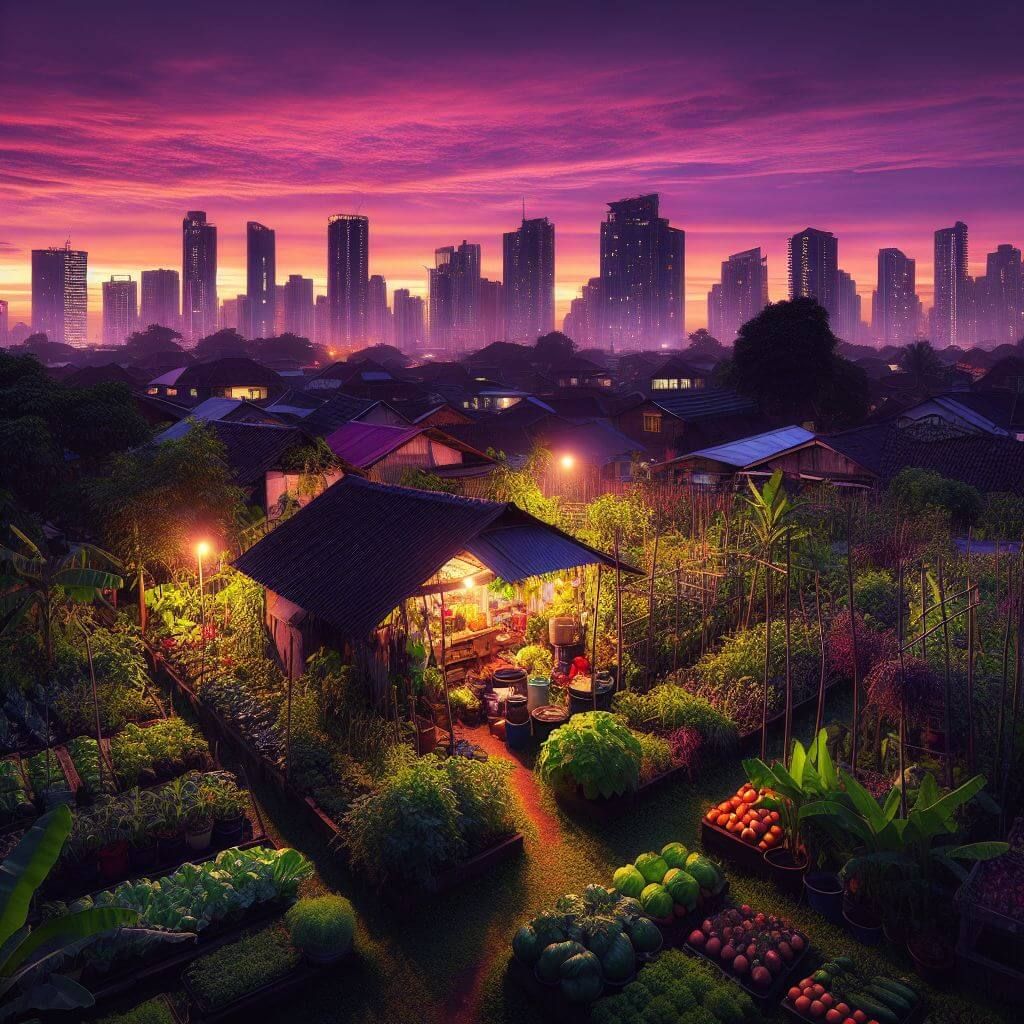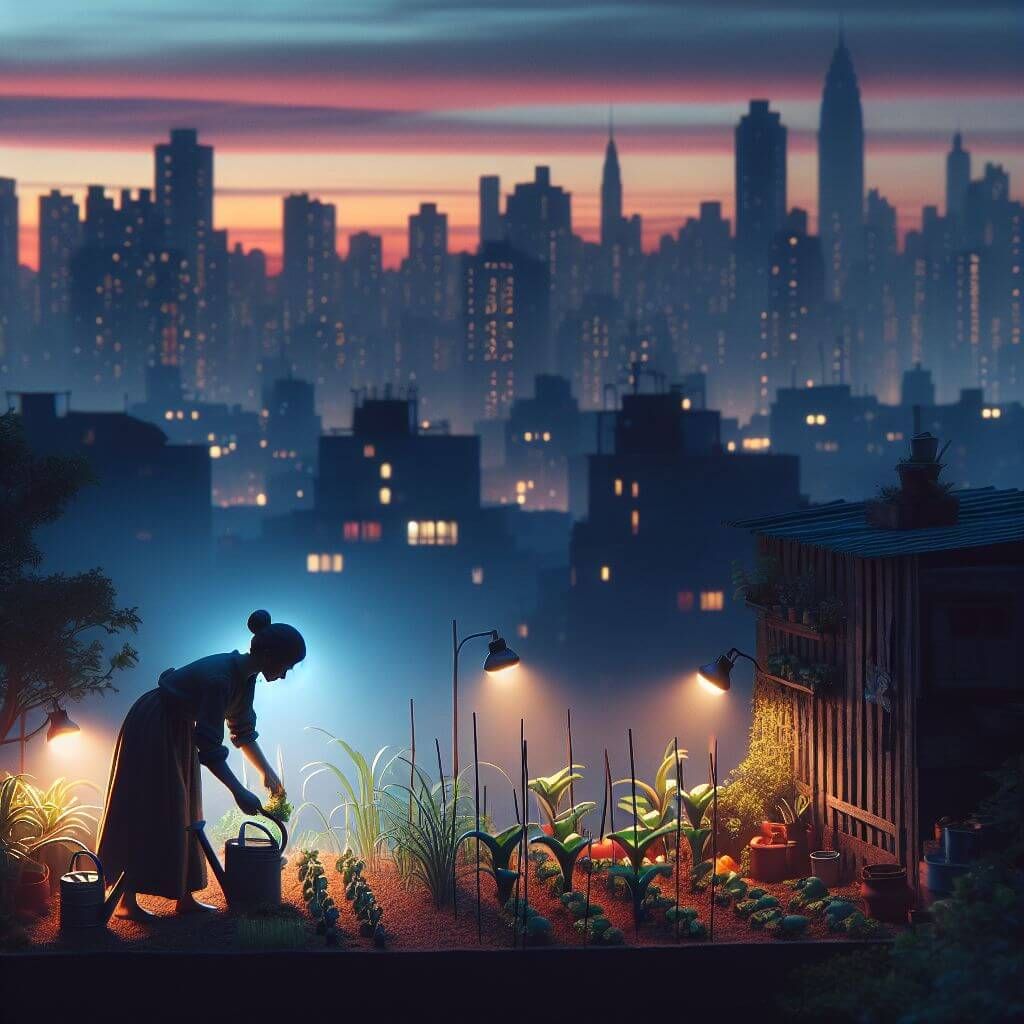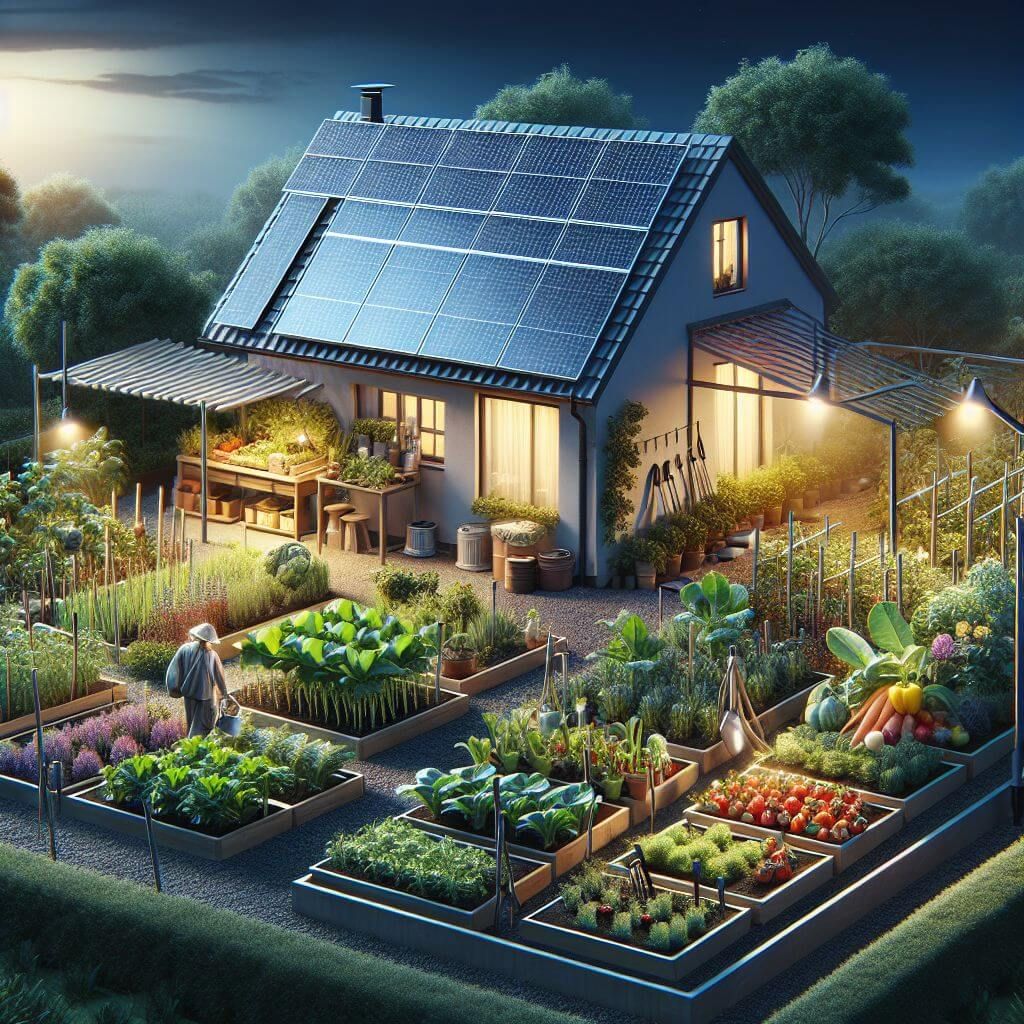
Article-at-a-Glance
Discover why twilight is the perfect time to tend to your urban garden.
Learn which plants flourish in cooler evening conditions and how to pick them.
Understand the best watering practices to keep your garden hydrated after sunset.
Explore soil and mulch techniques to protect your plants from the heat.
Get tips on arranging your garden to take advantage of twilight’s cooler temperatures.
As urban gardeners, we often face unique challenges, like limited space and intense heat from concrete jungles. But there’s a secret weapon in our arsenal: twilight gardening. As the sun dips and the city cools, it’s our time to shine—or rather, our gardens’ time to thrive. Let’s dive into how you can beat the heat and create an urban oasis that flourishes in the twilight hours.
Why Twilight is a Gardener’s Ally Against the Heat
When the sun sets, the concrete and asphalt that have been soaking up heat all day begin to release it, creating a warmer microclimate that’s ideal for our green friends. The cooler air is easier on both plants and gardeners alike, reducing the stress caused by the intense midday sun. Plus, twilight offers a serene backdrop for us to connect with nature, unwind from our day, and get our hands dirty.
Most importantly, gardening during these cooler hours helps conserve water. Without the harsh sun, water evaporates more slowly, allowing plants to absorb more moisture and nutrients. This not only makes our watering efforts more efficient but also promotes deeper root growth and healthier plants.
Maximizing Plant Health in Cooler Evening Temperatures
Evening temperatures can be a game-changer for our plants. As the heat of the day subsides, plants can recover from the stress of the sun and repair any damage. This is the time when they can really focus on growth. To make the most of this time, we should:
Monitor the moisture level in the soil to ensure it’s not too dry or too wet.
Check for signs of heat stress on plants, such as wilting or brown edges on leaves.
Provide a boost of nutrients with a gentle, organic fertilizer to support recovery.
Because plants are less stressed in the evening, they’re better able to absorb the nutrients and water we provide, setting them up for success in the days to come.
Choosing the Best Plants for Twilight Gardening

Identifying Heat-Resilient Varieties
Not all plants are created equal when it comes to withstanding the heat. To build a garden that thrives in urban environments, especially during the twilight hours, we should focus on heat-resilient varieties. These plants have adapted to survive—and even flourish—in warmer temperatures. Look for plants with these characteristics:
Deep root systems that can access water from deeper in the soil.
Silver or grey foliage that reflects sunlight and conserves water.
Thick leaves that retain moisture.
When selecting plants, consider native species or those from similar climates. They’re more likely to be adapted to your area’s specific conditions and will require less babying to get established.
Top Picks for Low-Light Planting
Twilight doesn’t just offer a respite from the heat; it also brings lower light levels. This means we need to choose plants that don’t require full sun to thrive. Here are some top picks for your twilight garden:
Lavender: This fragrant herb loves the heat and doesn’t mind a bit of shade.
Impatiens: A colorful favorite that blooms even in low-light conditions.
Hostas: These leafy perennials are perfect for adding a lush, green touch to shaded areas.
Remember, while these plants can tolerate lower light, they still need some direct sun to perform their best. Aim for a spot that gets a few hours of sunlight earlier in the day.
Soil and Mulch: The Dynamic Duo for Heat Defense
When we talk about defending our plants against the heat, soil and mulch are our best allies. Think of them as a protective blanket that keeps the roots cool and hydrated. But not all soil is created equal, and the right mulch can make a world of difference.
Selecting Soil Additives for Temperature Regulation
Soil additives can be a game-changer for temperature control. For instance, adding organic matter like compost can improve soil structure, increasing its ability to retain water and stay cool. Perlite and vermiculite are also great for aerating the soil, which helps roots breathe and reduces overheating. Here’s what you can mix into your soil:
Compost: Enhances moisture retention and adds nutrients.
Perlite: Improves aeration and drainage.
Vermiculite: Retains moisture and nutrients for root uptake.
Effective Mulching Strategies to Retain Moisture and Cool Roots
Mulch is like the secret sauce for keeping plant roots happy during hot weather. It acts as an insulating layer, protecting the soil from direct sunlight and reducing water evaporation. For the best results:
Apply a 2-3 inch layer of organic mulch around your plants.
Choose mulches like straw, wood chips, or shredded bark that add nutrients as they break down.
Avoid piling mulch against plant stems to prevent rot.
By using these strategies, you’ll help ensure that your plants have the cool, moist environment they need to thrive, even as the city around them bakes in the summer heat.
How to Arrange Your Urban Oasis for Twilight Exposure

Position plants that require more sunlight in areas where they’ll catch the last rays of the day.
Use taller plants or structures to create shaded areas for plants that prefer indirect light.
Consider the path of the moon for nocturnal pollinators and night-blooming plants.
Arranging your garden to take advantage of the cooler twilight hours isn’t just about plant selection—it’s about placement. You want to capture that gentle evening light, but also provide protection from the still-warm early evening sun.
Strategic Plant Placement for Evening Shade Benefits
Strategic placement is all about understanding the movement of light and shadow in your space. Plants that are sensitive to intense heat can be placed where buildings or larger plants cast evening shadows. This way, they’ll get the sunlight they need without the scorching afternoon heat.
Designing a Garden Layout to Exploit the Cool of the Night
When designing your garden layout, think about how you can create a flow of air to cool your plants. Leave pathways open and avoid overcrowding, which can trap heat. Raised beds and containers can also help improve air circulation around your plants.
Pest Control: Safeguarding Your Garden As Daylight Fades
As the sun sets, some pests come out to play. Snails and slugs love the cooler, moist conditions of twilight, but there are ways to keep them at bay.
Natural Repellents and Barriers Ideal for Evening Use
Creating barriers with diatomaceous earth or crushed eggshells can deter crawling pests. Planting aromatic herbs like lavender and rosemary can also repel insects with their strong scents. If you prefer a more direct approach:
Set out traps for snails and slugs.
Introduce beneficial insects like ladybugs to control aphid populations.
Apply neem oil as a natural pesticide in the evening when beneficial pollinators are less active.
Monitoring and Managing Nocturnal Critters
Regularly inspect your garden for signs of nocturnal pests, such as chewed leaves or damaged stems. Installing motion-activated lights or sprinklers can also scare off larger critters like raccoons or opossums that might visit your garden at night.
Twilight Aesthetics: Enhancing Your Garden’s Evening Ambience

Twilight isn’t just a time to work in the garden; it’s a time to enjoy it. With the right touches, your garden can become a magical place as the day turns to night.
Choosing Lighting that Complements Your Plants and Space
Soft lighting can highlight the best features of your garden and create a serene atmosphere. Solar-powered LED lights are a sustainable choice, casting a gentle glow on pathways and plants. You can also use:
String lights for a festive feel.
Spotlights to accentuate trees or architectural plants.
Lanterns for a warm, inviting glow.
Lighting isn’t just decorative—it’s functional, too, allowing you to enjoy your garden after dark and spot any issues with your plants that need attention.
Decor Tips for an Enchanting Nighttime Garden Atmosphere
To create an enchanting nighttime garden atmosphere, think about adding elements that engage the senses. A small water feature can add soothing sounds, while fragrant flowers like night-blooming jasmine can perfume the air. And don’t forget about comfort—add a bench or a hammock where you can relax and take in the beauty of your twilight garden.
Practical Tools and Gear for Nighttime Gardening
When the stars begin to twinkle, having the right tools can make all the difference. Opt for gardening gear that will make your twilight sessions both enjoyable and productive. A headlamp or a hands-free light source is essential, allowing you to see what you’re doing without casting shadows. Comfortable, durable gloves will protect your hands in the dark, and lightweight, long-sleeved clothing will prevent any nicks or insect bites. Also, consider tools with reflective tape for easy location in the dim light.
Keep your tools organized and close at hand with a gardening tote or belt. This way, you can move seamlessly through your garden, making the most of the cooler hours without the frustration of misplaced pruners or trowels. Remember, your comfort is key, so invest in cushions for kneeling or a garden stool if you plan to spend extended time tending to your plants under the moonlight.
Safety Tips for Working in Lower Light Conditions
Safety should always be a top priority, especially when visibility is reduced. Always let someone know you’ll be out in the garden during twilight hours, just in case you need assistance. Keep pathways clear to prevent tripping, and if you’re using electrical tools or lights, ensure that all cords are safely out of the way or properly insulated to prevent accidents.
Stay aware of your surroundings. Urban environments can bring unexpected visitors, both human and animal. A secure garden fence and being mindful of the local wildlife can help you avoid any surprise encounters. Lastly, always have a first aid kit handy—you never know when a minor scrape or splinter will need attention.
FAQ
As twilight gardeners, we often have questions about how to best care for our plants when the sun goes down. Here are some answers to the most common queries:
What are the benefits of gardening during twilight hours?
Gardening during twilight hours comes with a host of benefits. The cooler temperatures are easier on plants and gardeners alike, reducing water evaporation and the risk of heat stress. There’s also a certain peace that comes with gardening as the day winds down, making it a perfect time to de-stress and connect with nature.
How can I tell if my plants are getting enough water at night?
To ensure your plants are getting enough water at night, check the soil moisture in the morning. It should feel damp, not saturated, a few inches below the surface. If the soil is dry, increase your watering slightly the next evening. Keep an eye on your plants for signs of over- or under-watering, such as yellowing leaves or wilted stems, and adjust accordingly.
Which plants thrive in cooler evening temperatures?
Many plants benefit from the respite that cooler evening temperatures provide. Some favorites for twilight gardening include ferns, astilbes, and bleeding hearts, which all prefer a bit of shade and cooler conditions. Vegetables like lettuce, spinach, and radishes also appreciate the drop in temperature, often resulting in crisper leaves and less bolting. For more insights on quick-growing vegetables that can benefit from twilight conditions, consider exploring options for emergency food production.
What type of lighting is best for a twilight garden?
For a twilight garden, the best lighting is subtle and gentle on the eyes. Solar-powered path lights can mark walkways, while string lights add a whimsical touch overhead. For task lighting, adjustable LED spotlights can illuminate specific areas without overwhelming the space with light.
How do I deal with pests that come out at night?
Dealing with nocturnal pests requires a combination of vigilance and preventive measures. Regularly inspect your plants for signs of pest activity. Employ natural deterrents like neem oil or insecticidal soap as a first line of defense. Encourage natural predators into your garden, such as bats and owls, by installing a bat house or an owl nesting box. If you have a persistent problem, a barrier like a floating row cover can protect your plants while still allowing air and moisture to circulate.
Twilight gardening is a delightful way to extend your enjoyment of your urban oasis and beat the daytime heat. With the right plants, tools, and strategies, you can transform your space into a thriving, magical nighttime garden. So grab your gloves, flick on your headlamp, and let’s get gardening under the stars!







Leave a Reply